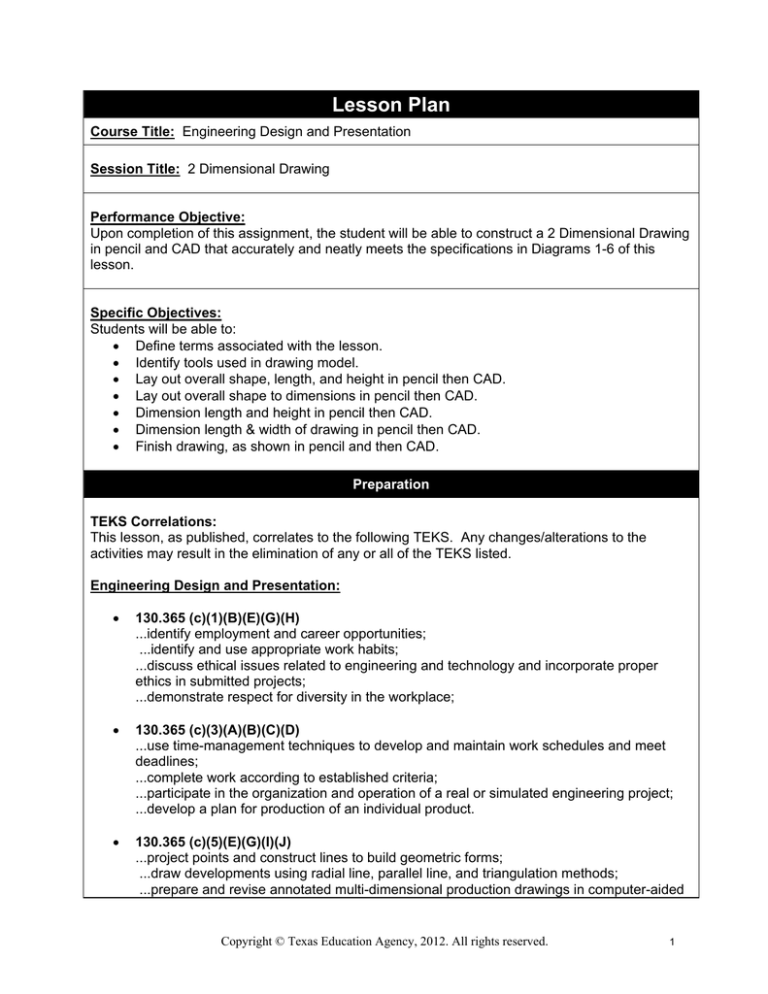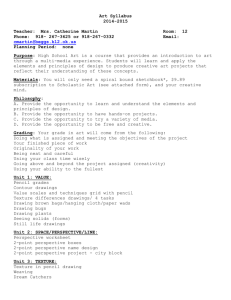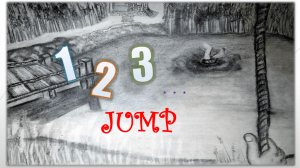Lesson Plan
advertisement

Lesson Plan Course Title: Engineering Design and Presentation Session Title: 2 Dimensional Drawing Performance Objective: Upon completion of this assignment, the student will be able to construct a 2 Dimensional Drawing in pencil and CAD that accurately and neatly meets the specifications in Diagrams 1-6 of this lesson. Specific Objectives: Students will be able to: Define terms associated with the lesson. Identify tools used in drawing model. Lay out overall shape, length, and height in pencil then CAD. Lay out overall shape to dimensions in pencil then CAD. Dimension length and height in pencil then CAD. Dimension length & width of drawing in pencil then CAD. Finish drawing, as shown in pencil and then CAD. Preparation TEKS Correlations: This lesson, as published, correlates to the following TEKS. Any changes/alterations to the activities may result in the elimination of any or all of the TEKS listed. Engineering Design and Presentation: 130.365 (c)(1)(B)(E)(G)(H) ...identify employment and career opportunities; ...identify and use appropriate work habits; ...discuss ethical issues related to engineering and technology and incorporate proper ethics in submitted projects; ...demonstrate respect for diversity in the workplace; 130.365 (c)(3)(A)(B)(C)(D) ...use time-management techniques to develop and maintain work schedules and meet deadlines; ...complete work according to established criteria; ...participate in the organization and operation of a real or simulated engineering project; ...develop a plan for production of an individual product. 130.365 (c)(5)(E)(G)(I)(J) ...project points and construct lines to build geometric forms; ...draw developments using radial line, parallel line, and triangulation methods; ...prepare and revise annotated multi-dimensional production drawings in computer-aided Copyright © Texas Education Agency, 2012. All rights reserved. 1 drafting and design to industry standards; ...demonstrate knowledge of effective file structure and management. 130.365 (c)(6)(B)(C)(D)(E)(F) ...think critically, identify the system constraints, and make fact-based decisions; ...use rational thinking to develop or improve a product; ...apply decision-making strategies when developing solutions; ...use an engineering notebook to record prototypes, corrections, and/or mistakes in the design process; ...use an engineering notebook to record the final design, construction, and manipulation of finished projects. 130.365 (c)(7)(A)(B)(C)(D) ...use a variety of technologies to design components; ...use tools, laboratory equipment, and precision measuring instruments to develop prototypes; ...research applications of different types of computer-aided drafting and design software; ...use multiple software applications for concept presentations. 130.365 (c)(8)(A)(B)(C)(D) ...interpret engineering drawings; ...identify areas where quality, reliability, and safety can be designed into a product; ...improve a product design to meet a specified need; ...produce engineering drawings to industry standards; 130.365 (c)(9)(A)(B)(C) ...identify and describe the steps needed to produce a prototype; ...identify and use appropriate tools, equipment, machines, and materials to produce the prototype; ...present the prototype using a variety of media. Interdisciplinary Correlations: English: 110.42(b)(6)(A)(B) …expand vocabulary through wide reading, listening, and discussing; …rely on context to determine meanings of words and phrases such as figurative language, idioms, multiple meaning words, and technical vocabulary; 110.42(b)(7)(A)(I)(J) …establish a purpose for reading such as to discover, interpret, and enjoy; …use study strategies such as skimming and scanning, note taking, outlining, and using study-guide questions to better understand texts; …read silently with comprehension for a sustained period of time; Mathematical Models with Applications: 111.36(b)(1)(A)(B)(C) Copyright © Texas Education Agency, 2012. All rights reserved. 2 …compare and analyze various methods for solving a real-life problem; …use multiple approaches (algebraic, graphical, and geometric methods) to solve problems from a variety of disciplines; …select a method to solve a problem, defend the method, and justify the reasonableness of the results; 111.36(b)(2)(A)(B)(C)(D) …interpret information from various graphs, including line graphs, bar graphs, circle graphs, histograms, scatter plots, line plots, stem and leaf plots, and box and whisker plots to draw conclusions from the data; …analyze numerical data using measures of central tendency, variability, and correlation in order to make inferences; …analyze graphs from journals, newspapers, and other sources to determine the validity of stated arguments; …use regression methods available through technology to describe various models for data such as linear, quadratic, exponential, etc., select the most appropriate model, and use the model to interpret information; 111.36(b)(3)(A)(B)(C) …formulate a meaningful question, determine the data needed to answer the question, gather the appropriate data, analyze the data, and draw reasonable conclusions; …communicate methods used, analyses conducted, and conclusions drawn for a dataanalysis project by written report, visual display, oral report, or multi-media presentation; …determine the appropriateness of a model for making predictions from a given set of data; 111.36(b)(4)(A)(B) …compare theoretical and empirical probability; …use experiments to determine the reasonableness of a theoretical model such as binomial, geometric, etc.; Teacher Preparation: The teacher should have all materials and equipment ready for class with the tools that will be used in the lesson displayed for the students to see. The teacher should have the Storyboard Diagrams 1-6 PowerPoint presentation ready. References: American National Standards Rules CAD related software of teacher’s choice Instructional Aids: 1. PowerPoint presentation of Diagrams 1-7, tools, and 2D drawings 2. Handout of Drafting Tools and Instruments 3. Handout of 2D drawings from PowerPoint presentation 4. 2D Rubric Materials Needed: 1. CAD Software Copyright © Texas Education Agency, 2012. All rights reserved. 3 2. Paper & Pencil 3. Student handouts Equipment Needed: 1. Overhead or LCD projector 2. Computer 3. Drafting board 4. 30,60, 45 degree angles 5. T-square Learner Preparation: The student should have knowledge of basic drafting skills for board work and basic computer and CAD software skills for computer application; and, previous knowledge of dimensioning to American National Standards Rules. Introduction Introduction (LSI Quadrant I): SAY: Today we are going to discuss how to lay out a 2 dimensional drawing. ASK: What do you think a 2 dimensional drawing is used for? SHOW: PowerPoint slides of 2 dimensional drawings; and, distribute handout printed from slides on 2 dimensional drawings. ASK: How would an engineer use 2 dimensional drawings? SHOW: The tools displayed in the classroom to be used in sketching and drawing. SAY: In this lesson, you will sketch a 2 dimensional drawing using pencil and paper to match Diagrams 1-6 in the slide presentation; then, you will draw a 2 dimensional drawing using CAD. Outline Outline (LSI Quadrant II): Instructors can use the PowerPoint presentation, slides, handouts, and note pages in conjunction with the following outline. MI Outline Notes to Instructor I. Define terms associated with the lesson. A. Length B. Height C. Dimension . Distribute handouts of Diagrams 1-6, tools and 2D drawings. Start PowerPoint Storyboard presentation to be used throughout the lesson. Teacher will discuss terms used in lesson. Copyright © Texas Education Agency, 2012. All rights reserved. 4 II. Identify tools used in drawing model. A. Drafting board B. 30, 60, 45 degree angles C. T-square Teacher shows PowerPoint slide showing picture of tools and refers to actual tools displayed in class. III. Lay out overall shape, length, and height in pencil and then CAD. A. Lay out overall shape as shown to scale as shown in Diagram 1. B. Draw in overall length and extend them down to overall height .50 spaces between segments as shown in Diagram 2. C. Draw in over all height and extend them across to opposite side .50 spaces between segments as shown in Diagram 3. Students will complete sketches of Diagrams 1-6 in pencil; then, drawings of Diagrams 1-6 using CAD. It is recommended that students complete all diagrams in pencil before completing diagrams using CAD; however, it is to the discretion of each teacher. The teacher uses Diagrams 1, 2, 3 as standards to be met by the students. IV. Lay out overall shape to dimensions. A. Construct L shape in each corner as shown and as dimensioned in Diagram 4. Students will continue to complete Diagrams in pencil; and then using CAD. The teacher uses Diagram 4 as standard to be met by the students. V. Finishing drawing. A. Finish drawing as shown in Diagram 5. VI. Dimension length and height of drawing. A. Dimension drawing by placing length on top of drawing. B. Place height dimensions on right side of drawing, according to American National Standards Rules, as shown in Diagram 6. Students will finish diagrams 1-6 in pencil; then, diagrams 1-6 using CAD. The teacher uses Diagram 5 as standards to be met by the students. Students will continue to complete Diagrams 1-6 in pencil; then, Diagrams 1-6 using CAD. The teacher uses Diagram 6 as standards to be met by the students. Copyright © Texas Education Agency, 2012. All rights reserved. 5 VII. Dimension length & width of drawing. A. Diagram 6. Students will continue to complete diagrams 1-6 in pencil; and then diagrams 16 using CAD. The teacher uses Diagram 6 as standards to be met by the students. Application Guided Practice (LSI Quadrant III): The teacher uses PowerPoint Storyboard Diagrams 1-6 to guide the instruction. Diagram 7 is used for extension and enrichment. The remaining slides are used to show drafting tools and instruments, and 2D drawings as samples for the students to see as they are sketching and drawing their own. Independent Practice (LSI Quadrant III) Students will practice 2 dimensional drawing in pencil and using CAD as guided by the teacher. Summary Review (LSI Quadrants I and IV): The teacher will orally review the terms and tools used in this lesson with the students. Evaluation Informal Assessment (LSI Quadrant III): The teacher monitors student progress throughout the guided practice, observes students dimensioning, monitors progression and redirects as needed. Formal Assessment (LSI Quadrant III, IV): Finished 2 dimensional drawings in pencil and using CAD. Extension Extension/Enrichment (LSI Quadrant IV): 1. Identify 2 dimensional drawings used in industry in magazines. 2. Identify some of the industries that use 2 dimensional drawings. 3. Repeat assignment in solid form by adding width (Polyline extrude) as seen in Diagram 7. Copyright © Texas Education Agency, 2012. All rights reserved. 6 Copyright © © Texas Texas Education Education Agency, Agency, 2012. 2012. All All rights rights reserved. reserved. Copyright 7 2 Dimensional Drawing Rubric Task Statement: Construct a 2 Dimensional Drawing. Task Assignment: Construct a 2 Dimensional Drawing that accurately and neatly meets the specifications in Diagrams 1-6 of this lesson by using pencil and then CAD. Concepts/Skills to be Assessed Lay out overall shape, length, and height in pencil then CAD Novice 1 Pencil sketch started (Possible 15 points) Lay out overall shape to dimensions in pencil then CAD (1-4 points) Pencil sketch started (Possible 15 points) Dimension length of line segment in pencil then CAD (1-4 points) Line segments not connected, double lines, over run corners (1-4 points) Line segments not connected, double lines, over run corners (1-4 points) Pencil sketch started (Possible 15 points) Dimension height of line segment in pencil then CAD (Possible 15 points) Finish drawing, as shown, in pencil then CAD (Possible 25 points) Neatness Criteria Categories (Novice to Exemplary) Developing Accomplished 2 3 Pencil Sketch Pencil and CAD lines completed going in the right direction (4-8 points) (8-10 points) Pencil Sketch Pencil and CAD lines completed going in the right direction (8-10 points) (4-8 points) Less line segments Lines are connected, not connected, less sharp, and intersect double lines, less over run corners (4-8 points) (8-10 points) Less line segments Lines are connected, not connected, less sharp, and intersect double lines, less over run corners (4-8 points) (8-10 points) Pencil Sketch Pencil and CAD lines completed going in the right direction (1-10 points) (10 to 14 points) Smudges, double Less smudges, few lines, light and double lines, less fuzzy lines over run (Possible 15 points) (1-4 points) (4-8 points) A = 66-100 points; B = 54-66 points; C = 30-54 points; D = 6-30 points (14 to 16 points) No smudges, lines intersect and are dark and sharp (8-10 points) Copyright © Texas Education Agency, 2012. All rights reserved. Exemplary 4 Pencil and CAD are accurate within 1/16 of an inch (10-15 points) Pencil and CAD are accurate within 1/16 of an inch (10-15 points) Dark, sharp lines with 100% accuracy (10-15 points) Dark, sharp lines with 100% accuracy (10-15 points) Pencil and CAD are 100% accurate within dimension given (16 to 25 points) Dark, sharp, accurate lines (10-15 points) Total Points: 8 Points Earned




